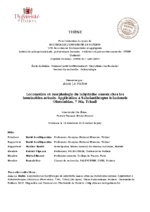Le Maître Anne
Locomotion et morphologie du labyrinthe osseux chez les hominoïdes actuels. Application à Sahelanthropus tchadensis (Hominidae, 7 Ma, Tchad)
frDépôt légal électroniqueConsulter le texte intégral de la thèse (format PDF)

Résumé
Français
Locomotion et morphologie du labyrinthe osseux chez les hominoïdes actuels. Application à Sahelanthropus tchadensis (Hominidae, 7 Ma, Tchad)
L’espèce humaine est caractérisée par une forme de locomotion bipède qui lui est propre. Toumaï, l’holotype de l’espèce Sahelanthropus tchadensis découverte au Tchad, est le plus ancien représentant connu du rameau humain. Daté de 7 millions d’années, il est très proche de la dichotomie entre ce rameau et celui des chimpanzés. C’est donc un témoin précieux des premières phases de l’évolution de la locomotion dans ce groupe. Le but de ce travail est de reconstituer le comportement locomoteur de Sahelanthropus tchadensis à partir de l’étude de la partie osseuse de son labyrinthe, organe de l’équilibre. Pour cela, les relations entre locomotion et morphologie du labyrinthe osseux sont recherchées chez les hominoïdes actuels. Les covariations entre le labyrinthe et le crâne sont étudiées chez Homo sapiens afin de déterminer l’influence sur la morphologie du labyrinthe de son intégration dans le crâne. Ces résultats sont enfin appliqués au labyrinthe de Toumaï, comparé à d’autres hominines fossiles. La morphométrie géométrique discrimine l’ensemble des espèces actuelles par l’orientation, la taille et la forme relatives de chacune des parties du labyrinthe. Cependant, la torsion et l’orientation relative des canaux semi-circulaires sont majoritairement liées à l’intégration du labyrinthe dans le crâne (orientation des pyramides pétreuses et de la face par rapport à la ligne médio-sagittale du basicrâne). Au contraire, l’excentricité des canaux et leur taille sont uniquement liées à la locomotion. Chez Sahelanthropus tchadensis, la taille des canaux semi-circulaires indique une espèce relativement plus agile que les grands singes. En revanche, il ne présente pas les rotations de canaux caractéristiques du genre Homo. La forme de ses canaux constitue une combinaison unique de caractères : canal postérieur rond et canal antérieur légèrement étiré, comme les humains et les australopithèques, mais canal latéral légèrement projeté postéro-latéralement, comme les gorilles et les babouins. Ceci indiquerait un comportement locomoteur associant le grimper vertical dans les arbres à des déplacements au sol bipèdes mais aussi quadrupèdes.
Mots-clés libres : Hominidae, Toumaï, Sahelanthropus tchadenis, miocène, Tchad, labyrinthe, oreille interne, locomotion, bipédie, morphométrie géométrique, intégration, basicrâne, face.
- Hominoïdes
- Sahelanthropus tchadensis
- Labyrinthe osseux
- Locomotion animale
- Base du crâne
English
Locomotion and morphology of the bony labyrinth in extant hominoids. Application to Sahelanthropus tchadensis (Hominidae, 7 Ma, Chad)
Humans are characterised by a specific form of bipedal locomotion. Toumaï, holotype specimen of Sahelanthropus tchadensis discovered in Chad, is the oldest known member of the human branch. Dated from 7 million years ago, it is very close to the dichotomy between this branch and the branch of chimpanzees. Therefore, it gives valuable information on the first stages of the evolution of locomotion is this group. The purpose of this work is to reconstruct the locomotor behaviour of Sahelanthropus tchadensis based on the study of the osseous part of its labyrinth, the balance organ. To this aim, the relationships between the locomotion and the bony labyrinth morphology are investigated in extent hominoids. The covariations between the labyrinth and the skull are studied in Homo sapiens in order to determine the influence of cranial integration on labyrinth morphology. Finally, these results are applied to the bony labyrinth of Toumaï, compared to other hominin fossils. Geometric morphometrics discriminates all extant species by the relative orientation, size and shape of each part of the labyrinth. However, the torsion and the relative orientation of the semicircular canals are mainly due to the integration of the labyrinth in the skull (petrous pyramids and face orientations relative to the midline of the basicranium). On the contrary, canal eccentricity and size are linked only to locomotion. In Sahelanthropus tchadensis, the canal size indicates that this species was more agile than great apes. However, it does not have the semicircular canal rotations characterising the genus Homo. The shape of its canals constitutes a unique combination of features: a round posterior canal and a slightly stretched anterior canal, as in humans and australopithecines, but a slightly posterolaterally projected lateral canal, as in gorillas and baboons. This is the sign of a locomotor behaviour associating vertical climbing in trees to both bipedalism and quadrupedalism on the ground.
Keywords : Hominidae, Toumaï, Sahelanthropus tchadenis, Miocene, Chad, labyrinth, inner ear, locomotion, bipedalism, geometric morphometrics, integration, basicranium, face.
Notice
- Diplôme :
- Doctorat d'Université
- Établissement de soutenance :
- Université de Poitiers
- UFR, institut ou école :
- UFR des sciences fondamentales et appliquées (SFA)
- Laboratoire :
- Institut de paléoprimatologie, paléontologie humaine : évolution et paléoenvironnements - IPHEP (Poitiers)
- Domaine de recherche :
- Paléontologie
- Directeur(s) de thèse :
- Patrick Vignaud, Michel Brunet
- Date de soutenance :
- 14 décembre 2015
- Président du jury :
- David Lordkipanidze
- Rapporteurs :
- David Lordkipanidze, Markus Bastir
- Membres du jury :
- Patrick Vignaud, Michel Brunet, Franck Guy
Menu :
-
-
À propos d'UPthèses
-
Voir aussi
Annexe :
-
Une question ?
Avec le service Ubib.fr, posez votre question par chat à un bibliothécaire dans la fenêtre ci-dessous :
ou par messagerie électronique 7j/7 - 24h/24h, une réponse vous sera adressée sous 48h.
Accédez au formulaire...
Université de Poitiers - 15, rue de l'Hôtel Dieu - 86034 POITIERS Cedex - France - Tél : (33) (0)5 49 45 30 00 - Fax : (33) (0)5 49 45 30 50
these@support.univ-poitiers.fr -
Crédits et mentions légales
